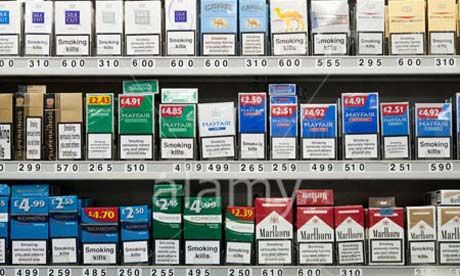
Australia's health minister Nicola Roxon is aiming for the country to be the first to introduce plain packaging for cigarettes. In what she calls a "courageous" move against the tobacco industry, legislation is expected to come into force on 1 July 2012 that will make all packets a uniform olive green with the name of the brand in small type. The World Medical Association has called on other governments to follow Australia's example.
Here in the UK, health secretary Andrew Lansley says he wants to look at the idea of introducing plain packaging so that brightly-coloured cigarette packets do not lure youths into smoking. The coalition government will launch an official consultation by the end of the year to discuss introducing plain packaging in England as part of its tobacco control plan. It is unlikely to happen soon, however, as ministers and the Department of Health have stated that they want to judge the effectiveness of the measure in Australia before making a firm decision.
The immediate rhetoric in favour of plain packaging is the protection of children: that by having dull, plain packages, minors, and indeed non-smokers, will not be tempted to buy a packet on impulse, having been enticed by the shiny packet. The measure is an extension of the ban on tobacco companies advertising their products.
No evidence exists, however, to suggest that anyone "impulsively" buys cigarettes, nor is there evidence that the policy would make any difference to smoking rates as no country has yet implemented it. Just as a teetotaller would not be persuaded to take up drinking just because WKD is colourful, there is nothing to suggest that non-smokers start smoking because the packet has fancy emblems. In fact, with large text warnings on the front and graphic pictures on the back taking up a large portion of the packaging, there is little left of the manufacturers' own designs.
A display ban in England has already been agreed on, which will come into effect from next year for large stores and 2015 for smaller shops such as newsagents, and if tobacco is being hidden then no one, child or adult, will be able to see the packets whether they are plain or decorated with flashing lights.
Behind the counter
We already have measures to stop children smoking. Cigarettes are always, without exception, kept behind the counter so neither child nor adult has any access to buying tobacco without the cashier physically handing it to them. Even if we accept the rationale that people impulsively want to smoke because the packet lures them in like fish to a worm on a hook, minors are still faced with the problem of needing to be in possession of identification proving they are over 18. Unlike alcohol, cigarettes cannot be pinched off the shelf and placed into a minor's pocket as they hurry out the door and around the back to spark up.
Indeed, if anything, alcohol is a far bigger concern because children can simply pick up a bottle of spirits, place it in their rucksack and walk out. Within minutes, they could suffer alcohol poisoning which could lead to death. There are other dangerous things in a shop that minors can impulsively take, such as paracetamol, but tobacco is not one of them.
As for existing smokers, people still buy alcohol with plain labels so it is unlikely smokers will be deterred by plain packaging. Rather, we may just see an increase in cigarette cases, which would allow minors to be as creative as possible, thus potentially encouraging them to take up the habit.
The NHS Information Centre report, Statistics on Smoking: England, 2011 noted that last year over a quarter of children aged 11 - 15 had tried smoking while 5% confessed to being regular smokers.
Undoubtedly, plain packaging will fail in reducing youth smoking rates because counterfeit cigarettes are far cheaper and the criminals selling them will not require identification proving the buyer to be over 18 - rates might even increase.
The real danger lies in the smuggling trade. With cigarettes now the most widely smuggled legal product and about 85% of cheap cigarettes sold on London streets being counterfeit, introducing a policy that would only make it easier for criminal outfits to mimic a packet should be cause for grave concern.
Richard White is the author of Smoke Screens: The Truth About Tobacco and writes about the latest policies on tobacco control.



Comment: See, your government cares about your children! Nevermind that they have indentured them and their children to lifetimes of debt slavery and promote foods that are killing them slowly, tobacco must be the culprit!
And now for the propaganda antidote: Pestilence, the Great Plague and the Tobacco Cure